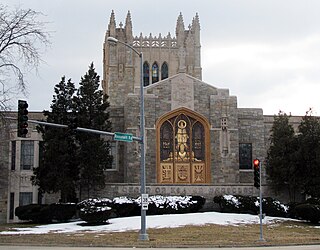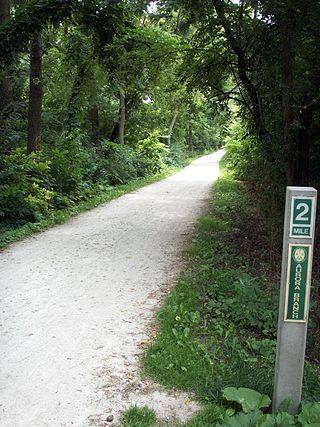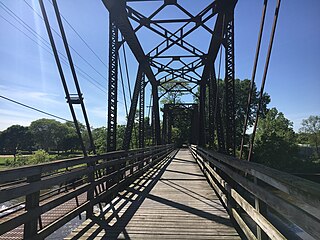Related Research Articles

Berkeley is a village located in Cook County, Illinois, United States. Incorporated in 1924, the population at the 2020 census was 5,338.

Hillside is a village in Cook County, Illinois, United States. As of the 2020 census it had a population of 8,320.

Villa Park is a village in DuPage County, Illinois, United States, within the Chicago metropolitan area. The population as of the 2020 Census is 21,113. Villa Park is a western suburb of Chicago.

West Chicago is a city in DuPage County, Illinois, United States. The population was 25,614 at the 2020 census. It was formerly named Junction and later Turner, after its founder, John B. Turner, president of the Galena and Chicago Union Railroad (G&CU) in 1855. The city was initially established around the first junction of railroad lines in Illinois, and today is still served by the Union Pacific West Metra service via West Chicago station.

The Chicago Aurora and Elgin Railroad (CA&E), known colloquially as the "Roarin' Elgin" or the "Great Third Rail", was an interurban railroad that operated passenger and freight service on its line between Chicago and Aurora, Batavia, Geneva, St. Charles, and Elgin, Illinois. The railroad also operated a small branch to Mt. Carmel Cemetery in Hillside and owned a branch line to Westchester.

The Illinois Prairie Path is a network of 61 miles (98 km) of bicycle trails, mostly in DuPage County, Illinois. Portions of the trail extend west to Kane County and east to Cook County. Most of the trail is categorized as rail-to-trail, meaning that the bicycle path is built atop a converted former railroad right of way. In the case of the Prairie Path, the vast majority of its routing runs on the former right-of-way of the Chicago Aurora and Elgin Railroad.

The Fox River Trolley Museum is a railroad museum in South Elgin, Illinois. Incorporated in 1961 as R.E.L.I.C., it opened in 1966 and became the Fox River Trolley Museum in 1984.

Oak Park is a station on the Chicago 'L' system, serving the Blue Line's Forest Park branch and Oak Park, Illinois. The station is alongside the Eisenhower Expressway between Oak Park Avenue and East Avenue, near the Oak Park Conservatory. The auxiliary entrance on East Avenue is half a block from the Oak Park Conservatory.
Thrall Car Manufacturing Company was a manufacturer of railroad freight cars in Chicago Heights, Illinois from 1917 to 2001. The company was sold to Trinity Industries in 2001.
The Aurora, Elgin & Fox River Electric (AE&FRE), was an interurban railroad that operated freight and passenger service on its line paralleling the Fox River. It served the communities of Carpentersville, Dundee, Elgin, South Elgin, St. Charles, Geneva, Batavia, North Aurora, Aurora, Montgomery, and Yorkville in Illinois. It also operated local streetcar lines in both Aurora and Elgin.
The Elmhurst Great Western Prairie (EGWP) is a six-acre, one mile long prairie remnant located immediately north of the Illinois Prairie Path in Elmhurst, Illinois. The EGWP has been maintained largely by volunteers since 1977 and is owned by the Elmhurst Park District.

The Fox River Trail is a multi-use path in Illinois along the Fox River. Largely in Kane County, the trail connects the communities of Algonquin, Carpentersville, Dundee, Elgin, South Elgin, St. Charles, Geneva, Batavia, North Aurora, Aurora, Montgomery, and Oswego.

The Metropolitan main line was a rapid transit line of the Chicago "L" system from 1895 to 1958. It ran west from downtown to a junction at Marshfield station. At this point the Garfield Park branch continued westward, while the Douglas Park branch turned south, and the Logan Square branch turned north with the Humboldt Park branch branching from it. In addition to serving the Chicago "L", its tracks and those of the Garfield Park branch also carried the Chicago Aurora and Elgin Railroad, an interurban that served Chicago's western suburbs, between 1905 and 1953.

Elmhurst Christian Reformed Church is a congregation of the Christian Reformed Church in North America located on the southern edge of Elmhurst, Illinois. It was founded in 1924 as a Baptist mission in Bellwood. The founder was a woman who had converted to Christianity after a difficult life in which she was won by her husband in a card game. After moving to Elmhurst in 1964, the congregation flourished and constructed a large new building just off of Roosevelt Road. It remains one of the largest congregations in the Christian Reformed denomination and runs many programs for children, students, adults, and seniors.

Marshfield was a rapid transit station on the Chicago "L" in service between 1895 and 1954. Constructed by the Metropolitan West Side Elevated Railroad, it was the westernmost station of the Metropolitan's main line, which then diverged into three branches. Marshfield was also served by the Aurora Elgin and Chicago Railway (AE&C) and its descendant the Chicago Aurora and Elgin Railroad (CA&E), an interurban, between 1905 and 1953.
Canal was a rapid transit station located on the Metropolitan main line of the Chicago "L" that was in service from 1895 to 1958, when the entire main line was replaced by the Congress Line located in the median of the nearby Eisenhower Expressway. Starting in 1927, the interurban Chicago Aurora and Elgin Railroad (CA&E) also served the station, continuing until 1953. The station connected with Chicago's Union Station, which was one of the city's rail terminals. One of the busiest stations on the Metropolitan's routes, and of the "L" in general, it opened a second entrance on Clinton Street in 1914.
Bellwood was a station on the Chicago Aurora and Elgin Railroad (CA&E) serving Bellwood, Illinois, from 1902 to 1957. An adjacent station, serving the Westchester branch, existed for rapid transit purposes on the Chicago "L" between 1926 and 1951.
Elgin was a station on the Chicago Aurora and Elgin Railroad, where it was the western terminus of the Elgin branch. Throughout the early 20th century, it also connected with the Elgin and Belvidere Railway and Aurora, Elgin and Fox River Electric Company (AE&FRE) interurbans.

St. Louis was a rapid transit station on the Chicago "L" between 1895 and 1953. It was constructed by the Metropolitan West Side Elevated Railroad and served its Garfield Park branch. The Chicago Aurora and Elgin Railroad (CA&E), an interurban serving Chicago's western suburbs, also used the Garfield Park branch's tracks in 1905. To accommodate the mixing of the fast interurban and slow "L" service on a two-track line, two crossovers were installed on either side of the St. Louis station to let CA&E trains pass "L" trains in 1911.
Kedzie was a rapid transit station on the Chicago "L", serving the Garfield Park branch of its Metropolitan West Side Elevated Railroad, from 1895 to 1958. Between 1905 and 1953, it also served the Chicago Aurora and Elgin Railroad (CA&E), an interurban using Garfield Park tracks, between 1905 and 1953.
References
- ↑ "York Street". GreatThirdRail.org. Retrieved February 27, 2023.
- ↑ Weller & Stark 1999, p. 43